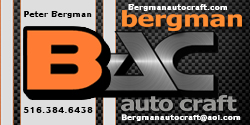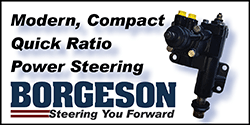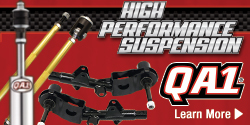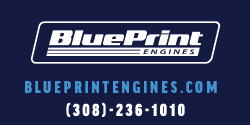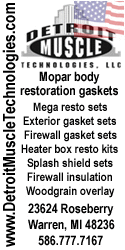You are using an out of date browser. It may not display this or other websites correctly.
You should upgrade or use an alternative browser.
You should upgrade or use an alternative browser.
67 Satellite 383 refresh - questions/advice
- Thread starter copper67sat
- Start date
BSB67
Well-Known Member
…….and found all of the exhaust valves were very tight in their guides while all the intakes dropped right out. The only exhaust valves that came out with minimal effort were #2 and #4. The rest will not come out without either using a puller from the valve side or drift from the stem side…….
Were they tight in the range of normal operating travel, or just during removal?
Always take a flat file and clean-up the valve where the keepers sit and on the top edge of the valve.
- Local time
- 3:00 PM
- Joined
- Aug 24, 2015
- Messages
- 830
- Reaction score
- 1,651
- Location
- West Palm Beach, FL
I was wondering why you hadn't been updating that thread. It's a good resource for what my engine should have had.My build is in paint jail at present. Self imposed, because I fired the guy that did much of the work, and am having trouble finding a competent person to finish up.
From what you indicated, you have some 915’s that would fill the bill. Your #1 problem is the pistons and you are going in the right direction there.
I am still on the fence here. The ported 915s I have look pretty rough. I don't remember where I got them, but know I didn't pay much, if anything, for them. Looking closer, I don’t think it was a professional job. The other pair came from another '67 383 I have and look untouched. I did a quick cc on one chamber and came up with 80cc, same as my current 516s. Both 915s have small valves and what I think are original, non-hardened exhaust seats.
My current thinking is that I can get a better flowing set of aluminum Stealth heads for about the same $ as it will cost to fix up any of my iron heads. Plus, I need to find a competent machine shop around here to do the work. I don't trust either of the 2 closest ones and I don't have any strong referrals yet since most of my Mopar buddies have moved away.
- Local time
- 3:00 PM
- Joined
- Aug 24, 2015
- Messages
- 830
- Reaction score
- 1,651
- Location
- West Palm Beach, FL
They are all snug compared to the intakes which dropped right out. Some will come out with minimal effort after cleaning up the lock grooves. 3 & 6 are tight within the normal operating range and the guides are moving in the head more than the valve is moving in the guide - I haven't seen 6 move in the guide at all.Were they tight in the range of normal operating travel, or just during removal?
Always take a flat file and clean-up the valve where the keepers sit and on the top edge of the valve.
I just set them in the corner and walked away after seeing that.
Last edited:
- Local time
- 3:00 PM
- Joined
- Aug 24, 2015
- Messages
- 830
- Reaction score
- 1,651
- Location
- West Palm Beach, FL
The 2315 has a CH of 1.92”. That piston will be about 0.015” - 0.018” below the deck in an in cut block.
That matches my calcs assuming the current pistons are Silv-O-Lite 1271s with a 1.848" CH. The block was not cut during the original rebuild, but may need skim cut now - need to check that.
With 80cc heads, Cometic C5460-027 gaskets (if I go with the Stealth heads) and 2315s. I calculated something like 9.8 CR. Accounting for the fire ring volume dropped that a bit.
EDIT: Rechecked my calcs. I was double-bookeeping the gasket compressed volume because Cometic provides that spec whereas I was calculating it for other options. Updated the calc and CR would be 9.8 with the setup above. Can always go lower CR with a thicker gasket, but I was trying to see how high I can get it without doing a lot of machining.
Last edited:
I have $760 in the 516 original heads. That's new valves, 1.74 and hardened exhaust seats, and the total valve job. Hope this helps.I was wondering why you hadn't been updating that thread. It's a good resource for what my engine should have had.
I am still on the fence here. The ported 915s I have look pretty rough. I don't remember where I got them, but know I didn't pay much, if anything, for them. Looking closer, I don’t think it was a professional job. The other pair came from another '67 383 I have and look untouched. I did a quick cc on one chamber and came up with 80cc, same as my current 516s. Both 915s have small valves and what I think are original, non-hardened exhaust seats.
My current thinking is that I can get a better flowing set of aluminum Stealth heads for about the same $ as it will cost to fix up any of my iron heads. Plus, I need to find a competent machine shop around here to do the work. I don't trust either of the 2 closest ones and I don't have any strong referrals yet since most of my Mopar buddies have moved away.
- Local time
- 3:00 PM
- Joined
- Aug 24, 2015
- Messages
- 830
- Reaction score
- 1,651
- Location
- West Palm Beach, FL
I think I spent about that much on the current 516s in 1990 - hardened seats, 3-angle valve job, bronze guides, milled surface, new valves. Head work and parts were about half of the overall machine shop cost. South FL shop rates are probably higher than AL, but sounds like you got a good deal to me.I have $760 in the 516 original heads. That's new valves, 1.74 and hardened exhaust seats, and the total valve job. Hope this helps.
When you go to larger valves, you get some port work without asking, because they have to blend the cuts into the ports.I think I spent about that much on the current 516s in 1990 - hardened seats, 3-angle valve job, bronze guides, milled surface, new valves. Head work and parts were about half of the overall machine shop cost. South FL shop rates are probably higher than AL, but sounds like you got a good deal to me.
- Local time
- 3:00 PM
- Joined
- Aug 24, 2015
- Messages
- 830
- Reaction score
- 1,651
- Location
- West Palm Beach, FL
Jerry, did you mill your heads and/or CC them? Curious where you think the CR is.When you go to larger valves, you get some port work without asking, because they have to blend the cuts into the ports.
No to both, but my guess is somewhere between 9.5 and 9.8. With all original components to the engine, I think it's as good as it left the factory in 67. I used steel shim head gaskets just as it left the factory with.Jerry, did you mill your heads and/or CC them? Curious where you think the CR is.
dvw
Well-Known Member
This is the classic how much performance do you want vs how much budget. If it's tight? I'd check the bearings and replace if needed. Thats as far as I'd go with the short block. The only reasonable gains in power in the short block are compression or a longer crank. Both are costly. Milling won't be worth the cost and hassle of what the gain would be. So what does that leave? Cam appears in good shape. It's also a very good cam for light performance use. With low compression you can't add much more cam. Shim head gaskets are a no cost compression boost. So that leaves heads. Depends on machining costs. Could be a toss up with aluminum heads. The closed chamber iron head will have more compression but the ports, chamber design, and plug location aren't great. The aliminum head would like more compression but the short block is what it is. I'd do what ever was the most cost effective. It's a driver 383 with a 3.23 gear and A/C. Don't try to make it what it's not. Repair whats broke and enjoy it.
Doug
Doug
BSB67
Well-Known Member
This.This is the classic how much performance do you want vs how much budget. If it's tight? I'd check the bearings and replace if needed. Thats as far as I'd go with the short block. The only reasonable gains in power in the short block are compression or a longer crank. Both are costly. Milling won't be worth the cost and hassle of what the gain would be. So what does that leave? Cam appears in good shape. It's also a very good cam for light performance use. With low compression you can't add much more cam. Shim head gaskets are a no cost compression boost. So that leaves heads. Depends on machining costs. Could be a toss up with aluminum heads. The closed chamber iron head will have more compression but the ports, chamber design, and plug location aren't great. The aliminum head would like more compression but the short block is what it is. I'd do what ever was the most cost effective. It's a driver 383 with a 3.23 gear and A/C. Don't try to make it what it's not. Repair whats broke and enjoy it.
Doug
- Local time
- 3:00 PM
- Joined
- Aug 24, 2015
- Messages
- 830
- Reaction score
- 1,651
- Location
- West Palm Beach, FL
Thanks Doug. I generally agree with what you posted and value your input as well as everyone else who has chimed in. The car is definitely more of a cruiser than a bruiser, but I don't mind throwing in some performance-minded upgrades if they make sense and increase the fun factor. That said, I am also mindful of the cost spiral. I'm not on a strict budget, but I want to get good bang for my buck and not spend on unnecessary or unwise changes.I'd do what ever was the most cost effective. It's a driver 383 with a 3.23 gear and A/C. Don't try to make it what it's not. Repair whats broke and enjoy it.
Doug
My first priority is addressing the heads since they need obvious work. After that, I may still consider options to get the compression ratio back closer to the ~10:1 it left the factory with though the current pistons seem to be the limiting factor there.
I don't think I want to throw any more $ into the current 516s so I'm currently torn between fixing up the stock, non-hp 915s I have or going with 440 Source Stealth aluminum heads. Decision really hinges on finding a local-ish machine shop I trust to install hardened 1.74 seats, do a good valve job and guides if needed and how much all that costs. I'm somewhat inclined to go with the Stealths if the costs are comparable though I know that's heading into the spiral. Both have closed chambers around 80cc's so they won't change the CR. The Stealths should flow better, but I don't know if the rest of my setup can really take advantage of that.
Going back to a steel shim head gasket would add a couple tenths of CR. May be better than nothing, but still leaves it at about 8.5. I've only found 1 option for those online so far - Mr Gasket - and the reviews weren't great. Open to recommendations.
Seems like changing pistons would be the best way to add another point or more of CR. Cost of pistons and rebalancing aren't too bad. Question is whether it's worth it for what may only be a 10-15 hp gain. Choice of iron v. aluminum heads probably factors in here.
That's where my thinking is today. Still more to do before I commit $ to any of these options. Hoping to tear down the short block this weekend to see if anything there needs attention. That may change my priorities.
dvw
Well-Known Member
I'd port the aluminum heads before spending $ on a compression increase. Power per dollar will be better. For what it's worth. I have a 73 Challenger that was built for my wife. 360, ported factory heads, LD340 dual plane, 650 Holley, 220/230 cam, headers, true 9.0-1, 3.55 gear. Runs on 87 octane. It has run 12.7@107 in full street trim. Compression is nice but it's not the end of the world.Thanks Doug. I generally agree with what you posted and value your input as well as everyone else who has chimed in. The car is definitely more of a cruiser than a bruiser, but I don't mind throwing in some performance-minded upgrades if they make sense and increase the fun factor. That said, I am also mindful of the cost spiral. I'm not on a strict budget, but I want to get good bang for my buck and not spend on unnecessary or unwise changes.
My first priority is addressing the heads since they need obvious work. After that, I may still consider options to get the compression ratio back closer to the ~10:1 it left the factory with though the current pistons seem to be the limiting factor there.
I don't think I want to throw any more $ into the current 516s so I'm currently torn between fixing up the stock, non-hp 915s I have or going with 440 Source Stealth aluminum heads. Decision really hinges on finding a local-ish machine shop I trust to install hardened 1.74 seats, do a good valve job and guides if needed and how much all that costs. I'm somewhat inclined to go with the Stealths if the costs are comparable though I know that's heading into the spiral. Both have closed chambers around 80cc's so they won't change the CR. The Stealths should flow better, but I don't know if the rest of my setup can really take advantage of that.
Going back to a steel shim head gasket would add a couple tenths of CR. May be better than nothing, but still leaves it at about 8.5. I've only found 1 option for those online so far - Mr Gasket - and the reviews weren't great. Open to recommendations.
Seems like changing pistons would be the best way to add another point or more of CR. Cost of pistons and rebalancing aren't too bad. Question is whether it's worth it for what may only be a 10-15 hp gain. Choice of iron v. aluminum heads probably factors in here.
That's where my thinking is today. Still more to do before I commit $ to any of these options. Hoping to tear down the short block this weekend to see if anything there needs attention. That may change my priorities.
Doug
- Local time
- 3:00 PM
- Joined
- Aug 24, 2015
- Messages
- 830
- Reaction score
- 1,651
- Location
- West Palm Beach, FL
Had to travel for work and take care of a few things around the house so progress has been slow, but I finally finished disassembling the short block.
Took a close look at the timing set. I know that I degreed the cam when I installed it, but I didn’t take very good notes. Factory setup would be dot-to-dot with the crank gear dot at 12 o’clock and the cam gear dot at 6 o’clock. I don’t see a dot on this crank gear. It has 3 keyways for 0, +4 and -4 and is currently set on -4, but that is at about 2 o’clock when the cam gear dot is at 6 o’clock. I recall going through this rather carefully the first time, but I don't remember what I did 35 yrs ago and it’s not obvious to me now why it’s set the way it is. There is very little slack in the timing chain so I don't think it jumped. I’ll have to study up on this before I put everything back together.

Pulled the cam out. Has what appears to be normal wear patterns, particularly over the nose of the lobes. Looks like I’ll be able to re-use it.

Pulled the pistons out. A couple of the bearings have a light groove in them that I can just catch with my fingernail, but otherwise look like normal wear. #2 rod journal has a similar light “stripe” over about 180 deg.
Hopefully just need to polish the crank and maybe replace the rod bearings.




The pistons look pretty good with some typical wear/scuffing on the skirts. However, #5 has a mark on it that looks like a crack. Need look into getting some dye pen to check it out or have it checked by a machine shop. #6 was little tight on the skirt coming out and looks more worn than the others. Otherwise, nothing obviously out of whack. Cylinder bores look pretty good as well. The only “ridge” is some deposits above the top ring. Clean that off and I can’t feel anything.


Finally, pulled off the main caps and removed the crank. Main journals and bearings look pretty good to me. Not seeing anything overly concerning on the bottom end.

The block is completely disassembled now. Got some feelers out to find a decent local machine shop to hot tank it, replace the cam bearings and give the cylinders a light hone. Need to sort out whether #5 piston is cracked and, if so, decide whether to replace just that one assuming I can find one or go with a new set. That will dictate what other work needs to be done.
A few questions on what to replace…new bearings – rod and/or main?; new rings?, new rod bolts – these are ARPs that I put in during the original rebuild?
I don’t see a need to replace the timing set or intermediate shaft. Need to disassemble and inspect the oil pump and need to check the cam, lifters and pushrods more closely before deciding if any of those need replaced, but they look ok on initial inspection.
Took a close look at the timing set. I know that I degreed the cam when I installed it, but I didn’t take very good notes. Factory setup would be dot-to-dot with the crank gear dot at 12 o’clock and the cam gear dot at 6 o’clock. I don’t see a dot on this crank gear. It has 3 keyways for 0, +4 and -4 and is currently set on -4, but that is at about 2 o’clock when the cam gear dot is at 6 o’clock. I recall going through this rather carefully the first time, but I don't remember what I did 35 yrs ago and it’s not obvious to me now why it’s set the way it is. There is very little slack in the timing chain so I don't think it jumped. I’ll have to study up on this before I put everything back together.
Pulled the cam out. Has what appears to be normal wear patterns, particularly over the nose of the lobes. Looks like I’ll be able to re-use it.
Pulled the pistons out. A couple of the bearings have a light groove in them that I can just catch with my fingernail, but otherwise look like normal wear. #2 rod journal has a similar light “stripe” over about 180 deg.
Hopefully just need to polish the crank and maybe replace the rod bearings.
The pistons look pretty good with some typical wear/scuffing on the skirts. However, #5 has a mark on it that looks like a crack. Need look into getting some dye pen to check it out or have it checked by a machine shop. #6 was little tight on the skirt coming out and looks more worn than the others. Otherwise, nothing obviously out of whack. Cylinder bores look pretty good as well. The only “ridge” is some deposits above the top ring. Clean that off and I can’t feel anything.
Finally, pulled off the main caps and removed the crank. Main journals and bearings look pretty good to me. Not seeing anything overly concerning on the bottom end.
The block is completely disassembled now. Got some feelers out to find a decent local machine shop to hot tank it, replace the cam bearings and give the cylinders a light hone. Need to sort out whether #5 piston is cracked and, if so, decide whether to replace just that one assuming I can find one or go with a new set. That will dictate what other work needs to be done.
A few questions on what to replace…new bearings – rod and/or main?; new rings?, new rod bolts – these are ARPs that I put in during the original rebuild?
I don’t see a need to replace the timing set or intermediate shaft. Need to disassemble and inspect the oil pump and need to check the cam, lifters and pushrods more closely before deciding if any of those need replaced, but they look ok on initial inspection.
Last edited:
- Local time
- 3:00 PM
- Joined
- Dec 31, 2020
- Messages
- 9,063
- Reaction score
- 21,785
- Location
- Ontario, Canada
I would begin by stepping the cam up a bit. I like the old Mopar Performance Magnum cam that replicates the cam found in 440 H.P. motors. Also 383 RoadRunner. It has a nice rumble and good street performance. Also, go with the newer style lifters and pushrods. For heads, I like the later model 440 "452" ones that already have hardened valve seats and 1.74" exhaust valves with better porting. These are open chambered heads, so use a shim head gasket to get some compression back.
Use an intake valley pan that has the heat riser ports blocked. I did this on the 440 in my 1967 R/T. If nothing else, it kept the fuel in the carb from boiling out after shut down, stinking up my garage for days. For an intake, I used an Edelbrock Performer aluminum one, with the lettering ground off, and painted engine colour. The 1971 383 iron intake was an improved design (one year only), approximating the design of the aluminium ones. It sounds like you have most of the other improvements covered. For a good street engine, you want lots of low end torque, even if it costs you some top end power. That is where your engine lives most of the time, anyway.
Use an intake valley pan that has the heat riser ports blocked. I did this on the 440 in my 1967 R/T. If nothing else, it kept the fuel in the carb from boiling out after shut down, stinking up my garage for days. For an intake, I used an Edelbrock Performer aluminum one, with the lettering ground off, and painted engine colour. The 1971 383 iron intake was an improved design (one year only), approximating the design of the aluminium ones. It sounds like you have most of the other improvements covered. For a good street engine, you want lots of low end torque, even if it costs you some top end power. That is where your engine lives most of the time, anyway.
dvw
Well-Known Member
If the cam bearings look good? Dont hot tank it. Just jet wash and brush. At times the cam bearings won't allow the cam to slide in. Then you have to scrape them. It's a pain.
Doug
Doug
- Local time
- 3:00 PM
- Joined
- Aug 24, 2015
- Messages
- 830
- Reaction score
- 1,651
- Location
- West Palm Beach, FL
Thanks. Really hoping I don't need to replace the cam. I've read too many horror stories about modern cams and lifters failing. This cam has about 35k miles on it and looks to be in good condition.I would begin by stepping the cam up a bit. I like the old Mopar Performance Magnum cam that replicates the cam found in 440 H.P. motors. Also 383 RoadRunner. It has a nice rumble and good street performance. Also, go with the newer style lifters and pushrods. For heads, I like the later model 440 "452" ones that already have hardened valve seats and 1.74" exhaust valves with better porting. These are open chambered heads, so use a shim head gasket to get some compression back.
Use an intake valley pan that has the heat riser ports blocked. I did this on the 440 in my 1967 R/T. If nothing else, it kept the fuel in the carb from boiling out after shut down, stinking up my garage for days. For an intake, I used an Edelbrock Performer aluminum one, with the lettering ground off, and painted engine colour. The 1971 383 iron intake was an improved design (one year only), approximating the design of the aluminium ones. It sounds like you have most of the other improvements covered. For a good street engine, you want lots of low end torque, even if it costs you some top end power. That is where your engine lives most of the time, anyway.
I decided to go with a set of 440 Source Stealth aluminum heads instead of putting that $ into iron heads.
An aluminum intake is on the wish list, but may not make the budget. Nice thing is that it is easy to make that change later if I change my mind.
- Local time
- 3:00 PM
- Joined
- Aug 24, 2015
- Messages
- 830
- Reaction score
- 1,651
- Location
- West Palm Beach, FL
If the cam bearings look good? Dont hot tank it. Just jet wash and brush. At times the cam bearings won't allow the cam to slide in. Then you have to scrape them. It's a pain.
Doug
Thanks Doug. Good advice as always. I have read about others having to scrape new bearings. Be nice to avoid that. Cam journals and bearings look good, but I'll inspect closer to be sure.
What is your opinion on replacing rod & main bearings? Seems like relatively cheap insurance vs reusing what was in there.
dvw
Well-Known Member
Depends on how they look and measure. if the rods snap in nice and pass those tests? i'd use them.Thanks Doug. Good advice as always. I have read about others having to scrape new bearings. Be nice to avoid that. Cam journals and bearings look good, but I'll inspect closer to be sure.
View attachment 1837459
What is your opinion on replacing rod & main bearings? Seems like relatively cheap insurance vs reusing what was in there.
Doug
Similar threads
- Replies
- 9
- Views
- 495
- Replies
- 11
- Views
- 981
- Replies
- 2
- Views
- 384



